Siraj ud-Daulah was an important historical figure in India in the mid-18th century. Born in 1733 in Bengal as Mirza Muhammad Siraj-ud-Daulah, he became the last independent Nawab of Bengal, Bihar, and Orissa. His life and rule were characterized by a mix of ambition, intrigue, and ultimately a tragic end to his reign.
Early Life and Ascension
Siraj ud-Daulah was Alivardi Khan’s grandson, and when his father, Zainuddin Ahmed Khan, was killed during his childhood, Alivardi recognized his grandson’s talent and legitimacy as a possible future ruler of Bengal. Siraj was brought up and trained by his grandfather, who was aware that the boy might face internal and external political and military challenges. However, despite his relatively low social status, Siraj was taught the basics of administrative skills and military strategy, which came in handy in forthcoming events.
Rise to Power
Siraj had an opportunity to accede to his throne after Alivardi’s death in April 1756, when the new governor became the Nawab of Bengal at the age of 23. It was a time of many internal and external challenges. The British East India Company had a strong influence in Bengal and was ready to expand it. Nonetheless, Siraj was willing to stand up to the British.
Conflict with the British
British conflict and Black Hole incident. One of the crucial moments of Siraj ud-Daulah’s rule is the so-called Black Hole incident. After his army seized Fort William in Calcutta in June 1756, the British colonists were confined in a small locked cell overnight and saw many victims caused by the lack of air and intense heat after the night. The sources differ on the exact number of casualties, but the event itself soon became the symbol of British indignation and the motivation for military intervention.
Battle of Plassey
The Black Hole incident ultimately exacerbated tensions between Siraj ud-Daulah and the British East India Company. Consequently, the British dispatched a military re-enforcement, led by their commander, Robert Clive, to confront his army physically. Eventually, the two armies met at the Battle of Plassey on June 23 rd, 1757. Even though Siraj’s forces numbered significantly more than the British, his army was roundly defeated due to high levels of betrayal and desertion in his ranks. A rumor that Siraj’s main general, Mir Jafar, was bribed by the British was highlighted. This caused a huge section of the Nawab’s army to defect during the middle of the battle. The battle of Plassey created a significant turning point in the history of the Indian sub-continent; it was marked as the day India was conquered by the British.
Fall from Power
After Plassey’s defeat, Siraj ud-Daulah’s power wilted away completely. He fled the battlefield and sought refuge in Murshidabad. Mir Jafar, the general who betrayed him during the battle, was installed as a puppet Nawab by the British. Initially, Siraj tried to rally some support behind him and reassume power He found out the hard way that most of the contingents that initially supported him abandoned him, while others maintained a neutral stance. Siraj made some desperate moves that only alienated him even further from his remaining supporters.
Capture and Execution
The downfall of Siraj ud-Daulah reached its zenith when the latter was betrayed by his officers and presented to British authorities. In June 1757, he was captured and admitted into the custody of Robert Clive’s forces. Although they promised and guaranteed him a fair trial, on July 2, 1757, the British authorities reportedly hanged him to death for treason. Siraj’s execution marked the end of independent Muslim states in Bengal and the start of British colonial hegemony in the region.
Legacy
Siraj ud-Daulah’s rule and subsequent execution are often viewed as an exemplary case of internal bickering and external interference. In some quarters, he is described as a tragic and stupid leader who was outmaneuvered by smarter adversaries. However, other individuals have painted him as the last monarch who stood boldly against foreign domination and a symbol of Bengalis’ quest for self-rule.
Conclusion
Siraj ud-Daulah’s life was a tragic and tumultuous voyage fraught with pursuit, betrayal, and dead ends. Although he did prompt the invasion of Bengal by the British, he did not die with shame because he fought back to the best of his abilities. His story and demise play a significant role in Bengal’s history regarding politics, power, resistance, sovereignty, and historical justice.

